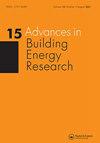Air conditioning energy consumption measurement and saving strategy analysis for an office building in hot summer and cold winter area
IF 2.5
Q2 CONSTRUCTION & BUILDING TECHNOLOGY
引用次数: 3
Abstract
ABSTRACT The energy consumption of different air conditioning systems varies greatly. In order to analyse the energy consumption status and energy-saving potential of air conditioning in existing office buildings, this paper takes an existing office building in hot summer and cold winter area as an example. The office and air conditioning energy consumption were continuously measured. The air conditioning energy consumption analysis model was established. With the measured data as input, the simulation calculation of the annual air conditioning energy consumption was carried out. The results showed that the measured value was quite different from the recommended value of the building energy efficiency standard. Changes in indoor air temperature or fresh air volume had a significant impact on air conditioning energy consumption. When the indoor set air conditioning temperature was 22°C in summer and 22°C in winter, the fresh air volume increased from 0 to 180 m3/(p·h), the increase of air conditioning power consumption reached 109.9% and 115.2%, respectively. The energy-saving envelope of the office building can obtain about 15% of the energy-saving benefits. However, users’ adjustment of operating parameters such as fresh air volume and indoor design temperature can easily lead to energy loss greater than that of energy-saving envelope.夏热冬冷地区某写字楼空调能耗测量及节能策略分析
不同空调系统的能耗差异很大。为了分析既有办公建筑空调的能耗现状和节能潜力,本文以夏热冬冷地区的既有办公建筑为例。连续测量办公室和空调的能耗。建立了空调能耗分析模型。以实测数据为输入,进行了空调年能耗的模拟计算。结果表明,实测值与建筑节能标准推荐值存在较大差异。室内空气温度或新风量的变化对空调能耗有显著影响。当室内空调设置温度夏季为22℃、冬季为22℃时,新风量从0增加到180 m3/(p·h),空调耗电量增幅分别达到109.9%和115.2%。办公楼的节能围护结构可获得约15%的节能效益。但是,用户对新风量、室内设计温度等运行参数的调整,容易导致能量损失大于节能围护结构的能量损失。
本文章由计算机程序翻译,如有差异,请以英文原文为准。
求助全文
约1分钟内获得全文
求助全文
来源期刊

Advances in Building Energy Research
CONSTRUCTION & BUILDING TECHNOLOGY-
CiteScore
4.80
自引率
5.00%
发文量
11
 求助内容:
求助内容: 应助结果提醒方式:
应助结果提醒方式:


